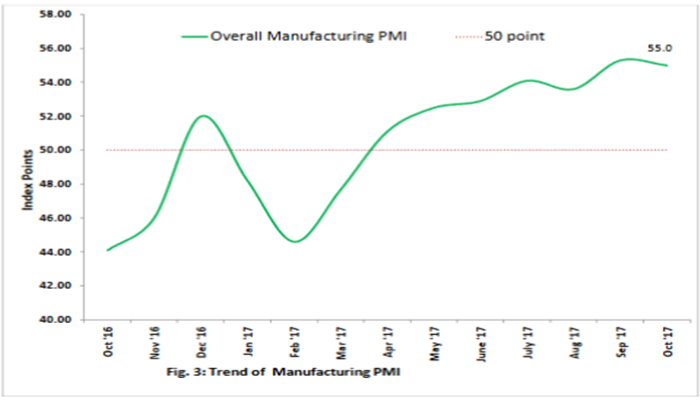
Purchasing Managers’ Index (PMI) Survey Report of the Central Bank of Nigeria (CBN) for the month of October indicates that the production level index for manufacturing sector grew for the eighth consecutive month in October 2017 at 58.4 points.
The index indicates an increase in production at a slower rate, when compared to its level in the preceding month. Eleven of the 16 manufacturing subsectors recorded increase in production level, while 5 remained unchanged during the review month.
According to the report, production level and new orders growing at a slower rate; while supplier delivery time, employment level and inventories growing at a faster rate in October 2017.
At 52.8 points, the new orders index grew for the seventh consecutive month. Seven subsectors reported growth, 2 remained unchanged while 7 contracted in the review month.
The supplier delivery time index for the manufacturing sector, at 55.5 points in October 2017, rose for the fifth consecutive month. Eleven subsectors recorded improved suppliers’ delivery time, 3 remained unchanged while 2 subsectors recorded delayed delivery
The employment level index in October 2017 stood at 53.1 points, indicating growth in employment level for the sixth consecutive month. Of the 16 subsectors, 7 recorded growth, 4 remained unchanged while 5 subsectors reduced their employment level in the review month
The composite PMI for the manufacturing sector is computed as the weighted average of five diffusion indices: production level, level of new orders, suppliers’ delivery time, employment level and raw materials inventory/work in progress.
The composite PMI for the non-manufacturing sector is computed from four diffusion indices: business activity, level of new orders, employment level and raw materials inventory, with equal weights of 25 per cent each.
The CBN explains that a composite PMI above 50 points indicates that the manufacturing/non-manufacturing economy is generally expanding, 50 points indicates no change and below 50 points indicates that it is generally contracting. The subsectors reporting growth are listed in the order of highest to lowest growth, while those reporting contraction are listed in the order of the highest to the lowest contraction.
According to the report, eleven of the 16 subsectors reported growth in the review month in the following order: plastics & rubber products; paper products; non-metallic mineral products; chemical & pharmaceutical products; textile, apparel, leather & footwear; food, beverage & tobacco products; furniture & related products; primary metal; electrical equipment; printing & related support activities; and fabricated metal products.
The appliances & components subsector remained unchanged, while remaining 4 subsectors contracted in the order: computer & electronic products; petroleum & coal products; cement; and transportation equipment.
At 56.5 points, inventories index grew for the seventh consecutive month, and at a faster rate when compared to its level in September 2017. Ten of the 16 subsectors recorded growth, 2 remained unchanged while 4 subsectors recorded decline in raw material inventories
Business activity, new orders and inventories grew at a faster rate; employment level growing at a slower rate in October.
The composite PMI for the non-manufacturing sector stood at 55.3 points in October 2017, indicating growth in the Non-manufacturing PMI for the sixth consecutive month.
Of the 18 non-manufacturing subsectors, 15 recorded growth in the following order: agriculture; utilities; finance & insurance; health care & social assistance; public administration; real estate rental & leasing; information & communication; transportation & warehousing; wholesale/retail trade; water supply, sewage & waste management; accommodation & food services; management of companies; arts, entertainment & recreation; electricity, gas, steam & air conditioning supply; and educational services. The construction; professional, scientific, & technical services; and repair, maintenance/washing of motor vehicles sub sectors recorded contraction in the review period
The business activity index grew to 57.5 points in October 2017, indicating growth for the seventh consecutive month. The index grew at a faster rate, when compared to its level in the previous month. Fourteen subsectors recorded growth in business activity, while 4 declined in the review month.
New orders index at 55.7 points grew in October 2017 for the seventh consecutive month. Of the 18 subsectors, 11 reported growth, 3 remained unchanged while 4 recorded declines.
The employment level Index for the non-manufacturing sector stood at 54.4 points, indicating growth in employment for the sixth consecutive month. Fifteen subsectors recorded growth in the review month, 1 remained unchanged while 2 recorded declines
At 53.4 points, non-manufacturing inventory index grew for the sixth consecutive month, indicating growth in inventories in the review period. Fifteen subsectors recorded higher inventories, while 3 subsectors recorded lower inventory in October, 2017.
The October 2017 PMI survey was conducted by the Statistics Department of the Central Bank of Nigeria during the period October 9 – 13, 2017. The respondents were purchasing and supply executives of manufacturing and non-manufacturing organizations in 15 locations in Nigeria.
The Bank makes no representation regarding the individual companies, other than the data they provided. The data contained herein further provides input for policy decisions.
The Manufacturing and Non-Manufacturing PMI Report on businesses is based on survey responses indicating the changes in the level of business activities in the current month compared with the preceding month.
For each of the indicators measured, this report shows the diffusion index of the responses. The diffusion index is computed as the percentage of responses with positive change plus half of the percentage of those reporting no change, except for supplier delivery time, which is computed as the percentage of responses with negative change plus half of the percentage of those reporting no change.






